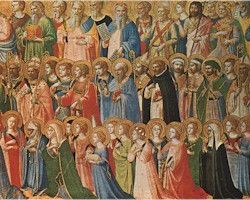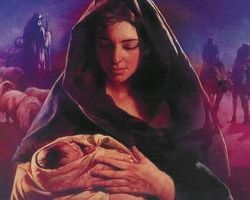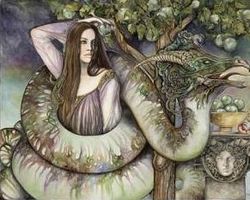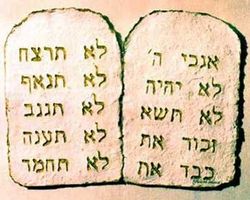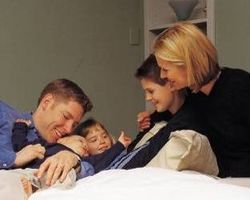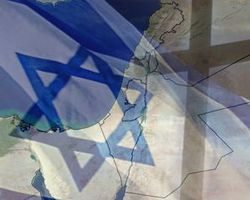An Introduction to the Catholic Church: Her Faith, Life, and Worship
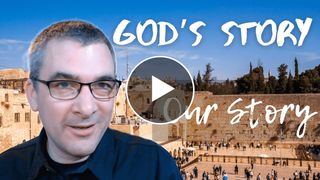
Click on the lesson title to open the presentation. After the presentation opens, click anywhere to move to the next animation. Or click on the arrows << >> to navigate between slides.
Click on the image to open the video (if available).
You may also view and download a PDF summary handout of each lesson.
This lesson is a review of part I of the course and an introduction to part II. It examines two questions: a) how does God speak to us? b) how does God save us? By reviewing the three roles of prophet, priest and king throughout salvation history, we can see how Jesus incarnated these roles and how he passed them on to the Church so that she could communicate Him – the way, the truth, and the life – to us through Sacred Scripture, Sacred Tradition, and the Church’s Magisterium. God progressively formed His people to be one, holy, catholic and apostolic.
Expands on lesson B01: God spoke to His people in salvation history through the offices of prophet, priest, and king. Jesus incarnated these three roles and passed them on to the Church through the apostolic succession. How revelation is transmitted through time. The problem with using the Bible as only source of revelation. The Bible and authority in the Early Church. The inspiration, inerrancy, and interpretation of Sacred Scripture. The four senses of Scripture. The role of Sacred Tradition and the magisterium’s infallible role in protecting the deposit of faith.
Continues the last lesson’s discussion on the Magisterium. Jesus chose Peter to be the Church’s rock and chief shepherd. The “keys to the kingdom” and the king’s “prime minister” in the OT. The prominence of Peter and of the church of Rome in the Early Church. Early testimony of Petrine succession. Peter’s successors throughout history. The pope, the college of bishops, and the Church’s teaching office. Papal infallibility. The pope as teacher, leader, and evangelist.
Now that we have studied the question of revelation and authority (why we should believe what the Church teaches), we can begin to look at how we are to live in God’s Kingdom. We first consider the goal of our journey. Only if we know where we are going and what are the consequences of our choices can we remain motivated to stay on the right path. The finality of death and the particular judgment each one will undergo. Heaven: the ultimate fulfillment of every human longing. Purgatory: its role, its presence in Scripture, and the concept of temporal punishment. Hell: The definitive self-exclusion from God and from the blessed. The resurrection of the body.
The communion of saints is God’s family in heaven and on earth and our deepest vocation. Who is a “saint”? The three states of the Church: the Church militant on earth, the Church triumphant in heaven, and the Church suffering in purgatory. The saints in heaven pray for the saints on earth, and we are called to communion with them. The saints on earth are to pray for those who suffer in purgatory. The Church will reach its perfection and full unity in the glory of heaven.
Now that we have learnt about the communion of saints we look at “God’s masterpiece” and the mother of all the saints: Miriam (Mary). We study Mary in relation to the three “mountain peaks” of OT salvation history: creation, the exodus, and the Davidic kingdom. Mary is the New Eve, the Ark of the New Covenant, and the Queen Mother. She is immaculate and without sin, ever-virgin, mother of Jesus and mother of the Church, and was assumed body and soul into heaven.
Now that we understand what is the Church and have studied her best examples – the saints and Mary – we begin to look at how to live the Christian life. This lesson and the following ones will apply OT salvation history to our own lives. This lesson returns to the purpose of man’s existence as willed by God at creation (Genesis 1-2, lessons A07-A08), and considers man’s dignity and vocation to beatitude, as created in the image of God and redeemed by the Messiah. Man’s freedom. The morality of human acts and passions. Moral conscience. The four cardinal virtues and the three theological virtues (faith, hope, love). The gifts and fruits of the Holy Spirit.
Our high calling and dignity as sons and daughters of God (Genesis 2, lesson B08) has been wounded by sin (Genesis 3, lesson A09). A review of original sin and its consequences. Concupiscence and how it leads to sin. The nature of sin and its effects. Mortal and venial sin. Sin and culpability. Temptation, sin, and conscience. Contrition, repentance, penance, and forgiveness.
Called to beatitude (Gen 2, lessons A08, B07), but wounded by sin (Gen 3, lessons A09, B08), man stands in need of salvation from God. Divine help comes to him in Christ through the law that guides him (Exodus, lesson A13 and this lesson) and the grace that sustains him (the NT, lessons A21-A29, B10-B11). The natural moral law, the Old Law (the Torah) and the New Law of the Gospel. The Ten Commandments are our “map of life”: they show us the way to live as God’s children and guide us on the way to holiness – our ultimate calling and vocation.
A review of how man lost God’s way, truth and life at the Fall, was cast out of paradise, and was left with a human nature prone to sin and condemned to suffering and death. How are we to find the way back to God? Through good works? Through religion? Through observing the moral law or Torah? These are all insufficient for salvation. Jesus’ Paschal Mystery accomplishes our salvation (lesson A27). But faith in Jesus is not enough to be saved. Faith and works. Salvation: one-time event or process over time? The Protestant view of salvation. Justification and sanctification. The new birth: baptism. Enduring to the end. The necessity of the Church for salvation.
The Law shows us the way we are to live (lesson B09), but it does not give us the power to live this life or to attain salvation (B10). God had to make this supernatural life possible by giving our soul new powers which it did not have by nature: grace – a participation in the life of God. Grace transforms us back to God’s image, sanctifies us and enables us to grow in the virtues. Actual grace and sanctifying grace. Charisms. How do we receive grace? Chiefly through the liturgy and sacraments of the Church. Growing in grace and losing grace. Gaining merit before God. The universal call to holiness.
This is an introductory lesson to the Church’s liturgy and sacraments. Now that we see the necessity of grace to live a holy life and attain salvation, we begin to look in more detail at how to receive grace. This lesson presents the OT background to the sacraments. Understanding Israel’s journey from Egypt to the Promised Land shows us how we are to live in order to reach heaven. Four stages: a) The Exodus and the tabernacle worship; b) fulfillment in the life of Christ, c) continued fulfillment in the life of the Church, the “New Exodus”; d) ultimate fulfillment in heaven.
This lesson continues the previous one and examines the theological and practical aspects of the Church’s liturgy. The liturgy is the summit of the Church’s activity and the font from which all her power flows. It is our participation in God’s work. The Trinitarian dimension of the liturgy: the Father is its source and goal; in it the Messiah continues his work of redemption through the Holy Spirit, which makes it efficacious. The seven sacraments are the powers of the Messiah which now work in the Church. The participants in the liturgy and how it is celebrated. The forms of the liturgy. Liturgical times and seasons.
Baptism is the gateway to eternal life and to the other sacraments. Baptism in the economy of salvation and the symbolism of water in the OT. Circumcision as the foreshadow of baptism. Jesus’ baptism. Baptism is the rebirth of water and the Spirit which truly saves. The baptized is buried with Christ. The celebration of the sacrament. Who can receive baptism? Should infants be baptized? Who can baptize? The necessity of baptism for salvation. The grace and effects of baptism.
Confirmation is the outpouring of the Holy Spirit which completes the baptismal grace and inserts the believer more fully into the Church’s mission. The prefiguring of confirmation in salvation history. Jesus’ promise of the Holy Spirit and the descent of the Holy Spirit at Pentecost. The celebration of confirmation: the laying on of hands and the anointing with chrism. The effects of confirmation. The seal of the Holy Spirit. Who can receive confirmation? The minister of confirmation.
The Eucharist is the source and summit of the Christian life. The Eucharist in salvation history: Melchizedek’s offering, the Passover, the manna. Jesus’ “bread of life” discourse, the Last Supper, and the Paschal Mystery. The Eucharist is thanksgiving to the Father, the memorial of the Messiah’s Passover and sacrifice of the Church, and the Real Presence of Christ among us. Transubstantiation. Eucharistic adoration. Preparation before receiving the Eucharist. The fruits of Holy Communion. The Eucharist and the unity of Christians. The Paschal banquet: the Eucharist is an anticipation of heavenly glory.
This lesson is the continuation of the lesson on the Eucharist. Review of the foreshadows of the Mass in Israel’s tabernacle worship (lesson B12). The Holy Mass is our participation in the Paschal Mystery and in the worship of the heavenly Jerusalem. Early Christian witness to the structure of the Mass. Overview of the different parts of the Mass: the liturgy of the Word and the liturgy of the Eucharist.
Even after baptism our new life as a child of God can be weakened and even lost by sin. Jesus willed that his Church continue his work of healing and salvation through the sacrament of reconciliation. Conversion, sacrifice and atonement in the OT. Jesus’ ministry of forgiveness. The paschal sacrifice makes possible man’s reconciliation with God. Jesus gave the ministry of reconciliation to His apostles and their successors. Interior penance; forms of penance. The acts of the penitent: contrition, confession, and satisfaction. The minister of the sacrament. The effects of the sacrament. The celebration of the sacrament.
By the sacred anointing of the sick and the prayer of the priests the Church commends those who are ill to the suffering and glorified Lord, that he may raise them up and save them. The sick person before God. Illness, sin and evil. Jesus’ ministry of healing, and His taking on our infirmities. Jesus gives to his disciples his ministry of healing. Redemptive suffering. Who receives and who administers the anointing of the sick? How is the sacrament celebrated? The effects of the sacrament.
Holy Orders is the sacrament through which the mission entrusted by Christ to his apostles continues to be exercised in the Church until the end of time. Holy orders in salvation history: the Aaronic priesthood. The institution of the Eucharist and of the New Testament priesthood. Jesus is both the High Priest and the sacrifice of the new covenant. The priesthood in the Early Church. The priesthood of all believers and the ordained priesthood. The priest acts in the person of Christ. The three degrees of Holy Orders: bishops, priests, deacons. The celebration of the sacrament. Who can be ordained? Priestly celibacy. The effects of the sacrament.
God’s plan for marriage and the family: God who created man out of love also calls him to love. The source of love in the Trinity. The “one flesh” union between man and woman and the nuptial meaning of the body. Be fruitful and multiply. The effects of the Fall on human love. Marriage under the Torah. God’s love for Israel. Jesus’ teaching on marriage. Free, total, faithful and fruitful love. The two dimensions of love: unity and procreation. Consecrated celibacy and virginity. Chastity and purity of heart.
In the covenant of marriage, a man and a woman establish between themselves a life-long partnership. The sacrament of matrimony. The celebration of marriage. Matrimonial consent. Annulments and impediments to marriage. Mixed marriages. The marriage bond. The grace of matrimony. Eros and agape. The goods and requirements of marriage: a) The unity and indissolubility of marriage; b) the fidelity of conjugal love; c) openness to fertility. Adultery, divorce, and other sins against the dignity of marriage.
The family is the domestic church. The role of the Christian family: a) forming a community of persons – the role of men, women, children, and the elderly; b) serving Life – the transmission of life (regulation of births, contraception, artificial insemination) and the education of children; c) participating in the development of society; d) sharing in the life and mission of the Church: the Christian family as a believing and evangelizing community, a community in dialogue with God, and a community at the service of man.
A brief overview of the history of the Church: the story of saints and sinners from the Acts of the Apostles, through the age of the Fathers, the Church in the Middle-Ages, the Protestant Reformation, the Church in the modern world, up to the 21st century.
God called Israel to be his kingdom of priests and perpetual witnesses to the world. The coming of Jesus the Jewish Messiah and His rejection by His own people. The early Jewish Church and her calling to bring the reconciliation of Jews and Gentiles. Paul’s illustration of the olive tree. The Church becomes predominantly gentile. The “passion of Israel” throughout Church history: replacement theology and Christian anti-Semitism. The “crucifixion” of Israel during the Holocaust. The resurrection of Israel? The modern rebirth of Messianic Judaism and Jewish Christianity. Modern anti-Semitism and the final redemption of Israel.
The Church has the obligation to evangelize all people and lead them to salvation in Messiah. Review of lesson B01 on the Church: man has lost the way, the truth, and the life; Jesus has come to restore these through His Church. The Great Commission calls for every believer to make disciples of all nations. Salvation is in no other name than Jesus. Faith in Christ, baptism, and the Church are necessary for salvation. The Church and other religions. The problem of relativism. Dialogue and evangelization. The Church and Judaism. The Church and the unity of Christians.
Go to: Introduction --- Portal to Lessons --- Part I: God's Story, Our Story
Purchase PowerPoint Presentations





